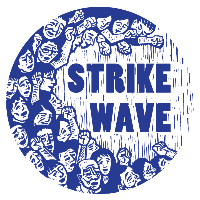Opinion: Sectoral Bargaining Needs Sectoral Organizing
by C.M. Lewis
UAW members occupy a General Motors facility as part of the Flint Sit-Down Strike. Library of Congress.
There is new energy behind the question of sectoral bargaining, including recent controversy over quasi-sectoral proposals. Given this, the Editors have decided to draw from past debates on union organization and industrial organization and republish relevant key arguments with new introductions. C.M. Lewis introduces our first piece with excerpts from labor leader William Z. Foster.
The need for sectoral bargaining—and in many cases, portraying it as a panacea—has become a commonplace point in debates on organized labor’s future.
Sectoral bargaining, as opposed to “firm level” bargaining (the typical form in the United States), is common throughout many European nations. In strong sectoral systems, unions bargain with employers to set common standards throughout a single industry or region—such as an agreement reached in Baden-Wurtenberg in 2018 between German union IG Metall and a major employer federation, Suedwestmetall, which set a twenty-seven hour workweek.
Not all sectoral bargaining systems are created equally. Some proposals, as those addressed in a recent book review for Strikewave, have problems. To give some precision to this debate, a range of experts including Veena Dubal, Sanjukta Paul, Marshall Steinbaum, and Jane McAlevey set forth foundational principles for sectoral bargaining in the United States. Their prescriptions give a conceptual foundation that grounds discussion of sectoral bargaining in worker power.
One element missing from the overall discussion, however, is the part that is most within our control: our own organization. Sectoral systems are often built upon stronger union amalgamation and industrial rationalization in union organization. Germany’s Deutscher Gewerkschaftsbund has only eight affiliates, compared to the AFL-CIO’s fifty-six (and the many large unaffiliated unions). In sharp contrast to the United States, German unions can credibly claim to represent all union workers within a given industry.
Union organization is less discussed in talk of sectoral bargaining, but is no less important to ensuring a viable sectoral bargaining system. Multi-union collective bargaining above the level of individual worksites does occur, as in Verizon agreements involving both CWA and IBEW, but requires trust and cooperation to be successful. A hypothetical example using California illustrates the problem. SEIU locals, National Nurses United, and the National Union of Healthcare Workers easily cooperating in bargaining a sectoral agreement for healthcare workers seems implausible at best—and division between unions in multi-union bargaining is to the immediate benefit of employers.
In order to allow a viable sectoral bargaining system, we must also address the question of our organization and how that allows or disallows strong sectoral bargaining. This question resonates with debates over industrial organization in the 1920s and 1930s, with activists with the Congress of Industrial Organizations (C.I.O.) arguing for industrial organization. William Z. Foster, a labor leader active with the Trade Union Educational League and the Communist Party USA, was a chief proponent of industrial organization.
Below is an excerpt from “A Manual of Industrial Unionism,” written by Foster as a pamphlet in 1937. In the pamphlet, he presents a comprehensive and powerful argument for industrial organization. This excerpt addresses the question of industrial councils; the full document can be found here.
II. The Local Industrial Council
The various local unions of an industrial union in a given city or local community have many problems which they must deal with in common and, therefore, they should be united together in a local industrial council of their own industry. Thus, the many local unions in the big Chicago stockyards should be formed into one packing house workers’ council. For the same general reasons, the numerous unions in the steel mills in Pittsburgh should be combined into one inclusive steel workers’ council and, likewise, the various unions of the auto plants of Detroit should be formed into one auto workers’ council; and so on in all communities where there are several local unions in any one given industry.
Such local industrial councils, which may be named variously in different unions, should consist of a broad representation from the local unions that form their base and they should avoid the system of being merely narrow committees of business agents and other bureaucratic officials that characterize the corresponding local craft union councils (of carpenters, machinists, etc), of the A. F. of L. The new local industrial councils should hold periodic broad conferences of rank-and-file representatives of their constituent local unions; they should be active organizing agents in their industry locally and should generally stimulate the growth and functioning of the constituent local unions.
III. The District Industrial Council
The local industrial unions and local industrial councils of a given national industrial union should also form councils of a district or regional character, in order to deal with the many problems that arise in these larger areas—problems of organization, support of strikes, and many other matters. The district industrial councils (named as they may be in the several unions) should be based on natural industrial divisions such as, for example, a broad mine field, a big steel district containing many mill towns, an extensive textile area, a railroad system, etc.; or they may correspond to political divisions, as, for example, a state building trades council, etc. As in the case of the local industrial councils, these district or regional industrial councils should be built on a rank-and-file representation, instead of upon the narrow A. F. of L. system of little cliques of officials for corresponding types of organization. They should also hold broad periodic conferences of rank-and-file delegates.
C.M. Lewis is an editor of Strikewave and a union activist in Pennsylvania.

